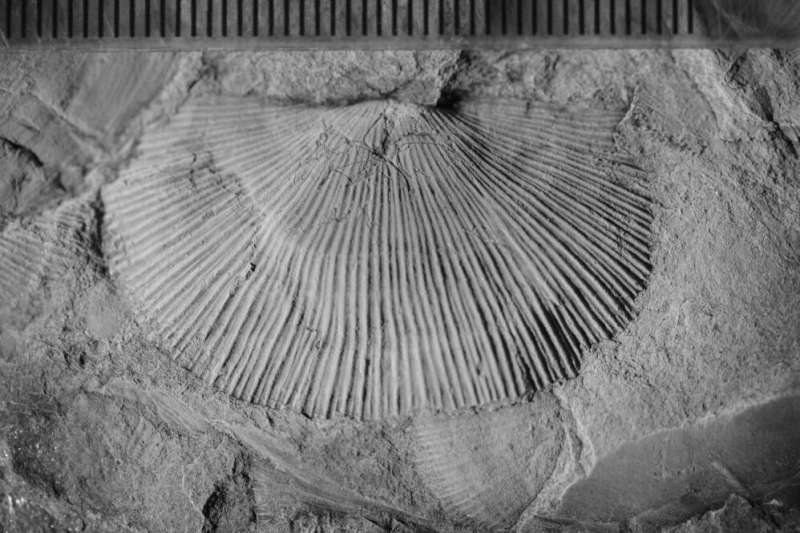One of the brachiopods (Floweria chemungensis) samples collected as part of this study. Credit: Andrew Bush
The Late Devonian mass extinction (roughly 372 million years ago) was one of five mass extinctions in Earth's history, with roughly 75% of all species disappearing over its course. It happened in two "pulses," spaced about 800,000 years apart, with most of the extinctions happening in the second pulse. However, for one group of animals living in eastern North America, the first pulse dealt the deadlier blow.
Research out today in Scientific Reports looks at how and why this group of animals, called brachiopods, seemed to do the opposite of so many other species. What caused this group to hit the accelerator toward extinction?
Brachiopods are small, shelled, filter-feeding ocean dwellers that are extremely abundant and well-preserved in the fossil record, says researcher Jaleigh Pier '18 (CLAS), now a Ph.D. student in Earth and Atmospheric Sciences at Cornell University. These qualities make brachiopods ideal for studying disturbances, like mass extinctions, from the deep past.
Pier started this research as a master's student in the Department of Ecology and Evolutionary Biology in the lab of Professor Andrew Bush, who is a member of EEB and Geosciences. Many samples had been previously collected by others in Bush's group, including co-author and Ph.D. student Sarah Brisson (Department of Geosciences), who also helped with the identification and classification. The specimens were collected from several sites near the border of New York and Pennsylvania, which, in the Late Devonian, had been a shallow sea.
For this study, Pier identified around 8,000 brachiopod specimens to determine which species were present leading up to this first pulse, while Brisson identified the species that were still around after the extinction. Andrew Beard '21 Ph.D., with guidance from Professor Michael Hren from the Department of Geosciences, performed geochemical measurements to confirm the timing of the extinction pulses and to determine oxygen levels during the extinctions.
Bush says it was surprising to discover the first pulse was more detrimental to the brachiopods in this area, and they wanted to understand why. To answer this question, Pier says it is necessary to apply a comparative approach.
"We have to compare the samples before and after to get a sense of what survives and what completely disappears and goes extinct," Bush says. "There's selectivity: why do certain things die out and certain things survive? We already know the result, so we have to work backwards and see what the lines of evidence indicate about what happened to these species."
Pier says there are factors that can indicate a species' likelihood of surviving an extinction; for example, body size tends to correlate with temperature tolerance, where smaller animals are usually better suited to warmer environments.
Though this correlation does not always hold true, Pier says larger-scale patterns are necessary lines of evidence to draw from since tissues and DNA are not available.
Larger-scale patterns in body size, abundance, and the depth of water that the brachiopods seemed to prefer, can all yield insights and trends. The triggers that cause this disparity between survival and extinction are called kill mechanisms. For the Devonian, there are two primary hypotheses as to what could have triggered such a high extinction rate.
"One of the hypotheses for causes of the Devonian extinction was sea level change and the other was climate change," Pier says. "As the environment changed, this caused widespread anoxia, meaning animals couldn't breathe, and they die out and then the climate changed, so temperatures got cold in the Devonian."
To determine temperature tolerance, the researchers looked at different kinds of brachiopods in the Devonian at different latitudes and their corresponding thermal preferences. There is also the factor of mobility: for instance, as it was getting colder, if the animals were unable to move to warmer environments, that could be one reason some species went extinct.
"From our data, it seems climate change was the primary factor for the Devonian extinction in this part of New York and Pennsylvania," says Pier. "Temperatures were changing, and these brachiopods would have had a hard time moving around to a better environment because the area is geographically isolated. For our species, 70% of them were endemic to the region and it reflects that difficulty in migrating."
These broad patterns and concepts from past extinction events can be applied to understand similar patterns researchers are seeing today, says Pier, where some groups fare well while others die out.
Bush says, "In a general sense, climate change is an important aspect of extinction. In this paper we tried to get at this extra angle of the isolated biota and how that plays in. Most of the time in the fossil record, anything that happens within hundreds to thousands of years, you can't really tell it apart. Even if a mass extinction takes place over several thousand years, you might not be able to look at the detailed temporal spatial patterns of what happened when, but because this event was something that happened in a couple of pulses spread out in time we were able to look at these spatial and temporal patterns in a different way."
More information: Jaleigh Q. Pier et al, Accelerated mass extinction in an isolated biota during Late Devonian climate changes, Scientific Reports (2021). DOI: 10.1038/s41598-021-03510-6
Journal information: Scientific Reports
Provided by University of Connecticut
























